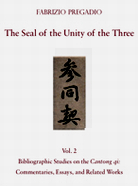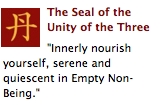The Seal of the Unity of the Three (Cantong qi)
Commentaries and Editions (Part 4)
Fabrizio Pregadio
These materials on the The Seal of the Unity of the Three, the main text of Taoist Internal Alchemy, are selected from:
Fabrizio Pregadio
Golden Elixir Press, 2011
Paperback
Part 1 of this book contains a bibliographic catalogue of about 150 extant and lost commentaries, essays, and other works related to the Cantong qi, with details on authors, dates, editions, and reprints. Part 2 contains a survey of the textual tradition of the Cantong qi, focused on the composition and contents of about 40 major texts.
 This page is part of a series on the Seal of the Unity of the Three. See the complete index.
This page is part of a series on the Seal of the Unity of the Three. See the complete index.
NOTE: This article contains notes on 28 of the 34 extant premodern commentaries of The Seal of the Unity of the Three. Commentaries are numbered according to numeration found in The Seal of the Unity of the Three, Vol. 2.
(14) Wang Wenlu 王文祿 (1503-86)
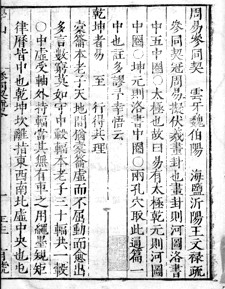
Bailing xueshan ed., 1584
Zhouyi cantong qi shulüe 周易參同契疏略, 1582
A Short Commentary on The Seal of the Unity of the Three
In addition to the Zhouyi cantong qi shulüe, the bibliophile and prolific author Wang Wenlu also published in 1568 an edition of the Cantong qi without commentary, entitled Cantong qi zhengwen 參同契正文 (The Correct Text of The Seal of the Unity of the Three). The Shulüe is meant to be read with the Zhengwen: it does not contain the entire text of the Cantong qi, but only the first four and the last four graphs of each section, followed by Wang Wenlu's short annotations.
The untitled and unnumbered sections correspond to the chapters of Chen Zhixu's redaction (no. 9 above), except for chapter 33, which here is subdivided into six parts, and for chapters 34 and 35, which here are merged into a single chapter. The text is based on Chen Zhixu's redaction, but Wang Wenlu also accepts features peculiar to Yu Yan's redaction (no. 8).
The picture shows one page of the Bailing xueshan 百陵學山 edition, first published in 1584.
![]() The Seal of the Unity of the Three, Vol. 2, pages 56-57 and 166-67
The Seal of the Unity of the Three, Vol. 2, pages 56-57 and 166-67
(16) Peng Haogu 彭好古 (fl. 1586-99)

Daoyan neiwai bijue quanshu ed.,
1599/1600
Guwen cantong qi 古文參同契, 1599
The Ancient Text of The Seal of the Unity of the Three
No precise information about Peng Haogu and his life appears to be available. Certain details found in his prefaces to his collected works, the Daoyan neiwai bijue quanshu 道言內外祕訣全, and to his Cantong qi commentary suggest, however, that he was in touch with Taoist circles.
The text found in his Guwen cantong qi follows the sequence of the original version of the "Ancient Text" of the Cantong qi.
This page is reproduced from the 1599/1600 edition of the Daoyan neiwai bijue quanshu, reprinted in Zangwai daoshu 藏外道書, vol. 6 (Chengdu: Ba-Shu shushe, 1992).
![]() The Seal of the Unity of the Three, Vol. 2, pages 57-58 and 190
The Seal of the Unity of the Three, Vol. 2, pages 57-58 and 190
(17) Huang Shiying 黃士英 (late 16th century ?)
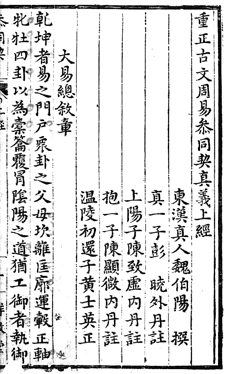
Xiangqi tang ed. (late 16th century?)
Chongzheng Guwen zhouyi cantong qi zhenyi 重正古文周易參同契真義, late 16th century (?)
The True Meaning of the Ancient Text of The Seal of the Unity of the Three, Newly Corrected
Huang Shiying's Chongzheng Guwen zhouyi cantong qi zhenyi is one of several works that include commentaries by more than one earlier author. The commentaries included here are those of Peng Xiao (no. 3 above), Chen Xianwei (no. 7), and Chen Zhixu (no. 9).
Despite its title, which contains the term "Ancient Text" ("Guwen" 古文), Huang Shiying's work is based on the standard text of the Cantong qi, as shown by its first section reproduced here from the Xiangqi tang 祥啟堂 ed. (late 16th century?).
![]() The Seal of the Unity of the Three, Vol. 2, pages 58-59
The Seal of the Unity of the Three, Vol. 2, pages 58-59
(19) Zhen Shu 甄淑 (fl. 1636)
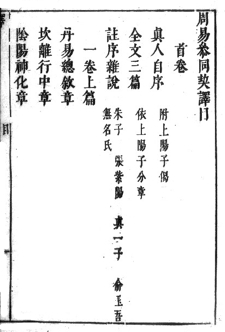
1636 ed.
Zhouyi cantong qi yi 周易參同契譯, 1636
Explanation of The Seal of the Unity of the Three
Having obtained his jinshi degree, Zhen Shu began a career as official that eventually led him to become Minister of Justice in 1639. After a short time, he was accused of corruption and sentenced to jail, where he died.
The front matter of his commentary contains several writings variously dated between 1626 and 1637. The text of the Cantong qi is reproduced twice, first without commentary, and then with Zhen Shu's annotations.
The text, which is divided into 35 chapters, is mainly based on Chen Zhixu's redaction (no. 9 above). The textual notes found at the end of several sections show, however, that Zhen Shu also knew the redactions by Zhu Xi (no. 4) and Yu Yan (no. 8).
An exemplar of the 1636 edition, reproduced here, is found at the Naikaku Bunko 内閣文庫 (Cabinet Library), Tokyo.
![]() The Seal of the Unity of the Three, Vol. 2, pages 61, 62, and 167-68
The Seal of the Unity of the Three, Vol. 2, pages 61, 62, and 167-68
© 2023 Fabrizio Pregadio and Golden Elixir Press



